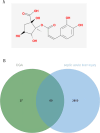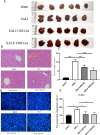Network pharmacology and molecular docking to explore the potential mechanism of chlorogenic acid in septic acute liver injury and experimental validation of TLR4/NF-κB pathway in vivo
- PMID: 39747465
- PMCID: PMC12125114
- DOI: 10.1007/s00210-024-03712-5
Network pharmacology and molecular docking to explore the potential mechanism of chlorogenic acid in septic acute liver injury and experimental validation of TLR4/NF-κB pathway in vivo
Abstract
The objective of this study was to investigate the biological activities and mechanisms of chlorogenic acid (CGA) in the treatment of septic acute liver injury (SALI) based on the network pharmacology, molecular docking, in vivo studies, and other techniques. Chlorogenic acid and potential related targets of septic acute liver injury were searched from the public databases. Then, the protein-protein interaction (PPI), Gene Ontology (GO), and Kyoto Encyclopedia of Genes and Genomes (KEGG) pathway enrichment analyses were conducted. Subsequently, molecular docking was performed to predict the binding of the active compound to the core target. Finally, in vivo experiments were carried out for further validation. A total of 60 common targets were identified between acute septic liver injury and chlorogenic acid, among which 9 common core targets (EGFR, ESR1, GSK3B, PTGS2, TLR4, PPARA, HSP90AA1, ACE, and MMP9) were screened with Cytoscape. Molecular docking indicated that these core targets had good binding activity to chlorogenic acid (- 7.2, - 6.8, - 7.7, - 8.7, - 6.1, - 6.8, - 7.3, - 8.4, and - 8.6 kcal/mol respectively). In the SALI mouse model, chlorogenic acid can improve pathological damage to the liver and apoptosis of liver cells, and anti-inflammatory properties significantly by the TLR4/NF-κB pathway (all P < 0.05). The biological activity and regulatory network of CGA on SALI were revealed, and the anti-inflammatory effect of CGA was verified, which could be associated with the TLR4/NF-κB pathway.
Keywords: Chlorogenic acid; Molecular docking; Network pharmacology; Septic acute liver injury; TLR4.
© 2024. The Author(s).
Conflict of interest statement
Declarations. Ethical approval: Our studies did not include human participates, human data, or human tissues. All animal experiments conducted were compliant were approved by the Institutional Animal Care and Ethics Committee of Wannan Medical College (LLSC-2024–073). Competing Interests: The authors declare no competing interests.
Figures





Similar articles
-
Chlorogenic acid alleviate kidney fibrosis through regulating TLR4/NF-қB mediated oxidative stress and inflammation.J Ethnopharmacol. 2024 Dec 5;335:118693. doi: 10.1016/j.jep.2024.118693. Epub 2024 Aug 12. J Ethnopharmacol. 2024. PMID: 39142620
-
Exploring the Anti-PANoptosis Mechanism of Dachaihu Decoction Against Sepsis-Induced Acute Lung Injury: Network Pharmacology, Bioinformatics, and Experimental Validation.Drug Des Devel Ther. 2025 Jan 17;19:349-368. doi: 10.2147/DDDT.S495225. eCollection 2025. Drug Des Devel Ther. 2025. PMID: 39839500 Free PMC article.
-
Network pharmacology and experimental analysis of Yudantong decoction, a multi-immunomodulator for the treatment of intractable cholestatic liver disease: Identification of active agents, molecular targets, and mechanisms of action.Int J Clin Pharmacol Ther. 2025 May;63(5):220-238. doi: 10.5414/CP204695. Int J Clin Pharmacol Ther. 2025. PMID: 40013962
-
[Mechanism of Berberis atrocarpa anthocyanin against Alzheimer's disease based on network pharmacology and experimental verification].Zhongguo Zhong Yao Za Zhi. 2023 Feb;48(3):778-788. doi: 10.19540/j.cnki.cjcmm.20220905.706. Zhongguo Zhong Yao Za Zhi. 2023. PMID: 36872242 Chinese.
-
Screening the effective components of Lysionotus pauciflorus Maxim. on the treatment of LPS induced acute lung injury mice by integrated UHPLC-Q-TOF-MS/MS and network pharmacology.J Ethnopharmacol. 2025 Jan 30;337(Pt 2):118887. doi: 10.1016/j.jep.2024.118887. Epub 2024 Oct 5. J Ethnopharmacol. 2025. PMID: 39374881
References
-
- Bagdas D, Etoz BC, Gul Z et al (2015) In vivo systemic chlorogenic acid therapy under diabetic conditions: Wound healing effects and cytotoxicity/genotoxicity profile. Food Chem Toxicol 81:54–61 - PubMed
-
- Chen YK, Ngoc NTM, Chang HW et al (2022) Chlorogenic acid inhibition of esophageal squamous cell carcinoma metastasis via EGFR/p-Akt/snail signaling pathways. Anticancer Res 42:3389–3402 - PubMed
-
- Cong S, Yan F, Huaping T (2023) Network pharmacology and molecular docking to explore the potential mechanism of urolithin A in combined allergic rhinitis and asthma syndrome. Naunyn Schmiedebergs Arch Pharmacol 396:2165–2177 - PubMed
MeSH terms
Substances
LinkOut - more resources
Full Text Sources
Medical
Research Materials
Miscellaneous

